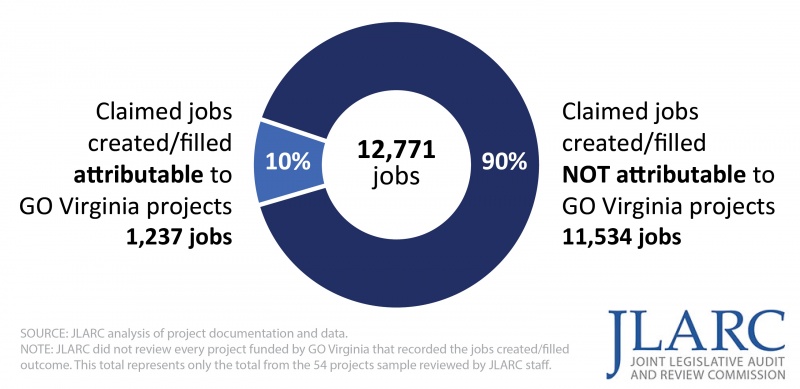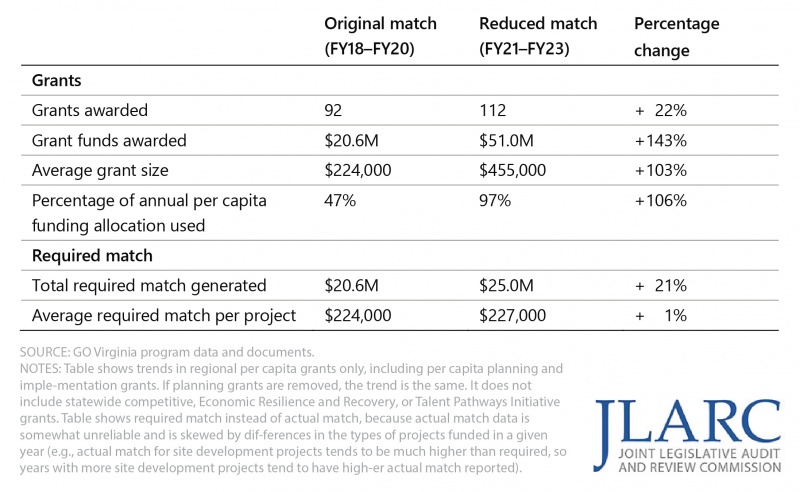GO Virginia Program

WHY WE DID THIS STUDY
In 2022, the Joint Legislative Audit and Review Commission (JLARC) directed staff to review the Virginia Growth and Opportunity (GO Virginia) program.
ABOUT GO VIRGINIA
The General Assembly created GO Virginia in 2016 with two main goals, which are set forth in statute: (1) promote regional collaboration and (2) grow and diversify regional economies. The program provides grants for economic and workforce development projects to support these goals. Grant projects must follow designated investment strategies in regionally targeted industries. GO Virginia is different from typical economic development programs because grants can go only to public and nonprofit organizations. GO Virginia does not provide funding directly to private businesses, and grants cannot be used to attract a particular business or as part of an incentive package. GO Virginia is governed by a state board and nine regional councils.
WHAT WE FOUND
GO Virginia appears to be improving regional collaboration, and many projects have positive regional economic impacts
GO Virginia appears to be facilitating greater collaboration within the state’s regional economies. Grants must involve the participation of at least two local governments, school divisions, or regional organizations, and all projects in a sample reviewed by JLARC met or exceeded this requirement. Eighty-two percent of the projects reviewed by JLARC staff involved additional collaboration with local entities, mainly local nonprofits or private businesses. GO Virginia also brought together key stakeholders to develop regional growth and diversification plans, which are required by the program.
Economic developers view GO Virginia positively, and many projects have had positive regional economic impacts. Seventy-seven percent of local economic development officers responding to a JLARC survey reported that GO Virginia had improved collaboration in their region and that the program was useful for promoting growth and diversification in their regional economies. Projects have had positive regional impacts, such as improving the availability of skilled workers in industries that are important to a region, and project leads unanimously stated that their projects would not have moved forward with the same scope or at the same pace without the program.
Unreliable outcomes data makes it difficult to estimate economic impact of GO Virginia and its projects
While it appears that some GO Virginia projects are helping to grow and diversify regional economies, the program’s overall success cannot be reliably measured because the outcomes data reported for many projects is unclear, inaccurate, or misleading. For example, JLARC staff found that several projects reported jobs that are not attributable to their project activity. The program’s outcome measure for jobs also combines two distinct activities with different economic benefits—number of jobs created and number of jobs filled—into a single measure. Finally, Department of Housing and Community Development (DHCD) staff said that projects should only count actual jobs created or filled for the measure, but in practice, several projects reported estimates of jobs that might have been created or filled. Because of these issues, only approximately 10 percent of the reported jobs created or filled by the sample of projects JLARC reviewed could reasonably be attributed to GO Virginia projects.
Only about 10 percent of jobs claimed to have been created or filled by a sample of GO Virginia projects could reasonably be attributed to the projects

Another problem with the outcomes data is there is no systematic verification that projects are reporting valid outcomes. Project leads are responsible for determining how to calculate their reported outcomes, but they receive little guidance on how to do so from DHCD or regional staff. Regional councils are ultimately responsible for verifying if the reported outcomes are reliable and accurate, but this is not being done thoroughly and consistently across regions. Verifying project outcomes is crucial for ensuring that individual project performance and overall program success can be accurately assessed. It is also critical for ensuring projects are accountable for performance.
Finally, there is limited collection and evaluation of outcomes beyond the two-year grant period, even though GO Virginia has been characterized as a long-term program. The Code vests the GO Virginia board with the power and duty to assess the program’s longer-term impact, and many GO Virginia projects remain active after the grant period and produce valuable outcomes. Collecting and reporting on post-grant information would provide valuable insight on the longer-term impact of individual projects and the program as a whole.
Traded sector eligibility requirement is unclear, and high-wage job creation requirement is unnecessarily restrictive
GO Virginia does not have a clear definition of what constitutes a traded sector industry or business activity, which contributes to confusion about which projects are eligible for the program. The board adopted an eligibility requirement that projects must generally be in the traded sector because business activity in this area brings in new revenue from outside the state and typically has the biggest potential for economic impact. However, the board policy does not clearly explain how a traded sector should be defined. In addition, healthcare is largely a non-traded sector industry, so healthcare projects are typically ineligible for GO Virginia grants. However, healthcare is essential to regional economies, and four regions have identified the importance of healthcare to their economic success in their regional growth and diversification plans.
GO Virginia guidance requires proposed projects to create new, high wage jobs, but most GO Virginia projects do not directly create jobs and job creation is not required by statute. The high-wage portion of the requirement can also conflict with the program’s statutory intent to focus on regional priorities, because some projects that address regional priorities may not be in occupations or industries that pay above average wages. A more appropriate way to ensure that proposed projects will have a high impact is to formalize the requirement that projects must entail a new workforce or economic development activity or expand an existing activity.
Match requirements and additional requirements for statewide competitive funds have limited the use of GO Virginia funds
GO Virginia’s match requirements limit utilization of program funds. The total match requirements for regional per capita grants, which account for most GO Virginia grants, were temporarily reduced from FY21–FY23 in response to the COVID-19 pandemic, and the local match was temporarily dropped. During this period, GO Virginia funded 22 percent more per capita projects, and the average grant size was twice as large. As a result, the program went from awarding less than half of its available per capita funds each year to awarding almost all of them, and actually generated more outside dollars. The temporarily reduced match requirements are set to expire in 2023, which may limit future use of funds.
DHCD’s multiple region eligibility requirement for statewide competitive funds is much stricter than prescribed by statute and appears to limit the program’s ability to make effective use of these funds. Less than half of statewide competitive funds have been awarded because it is challenging for regions to identify and carry out projects that meet this requirement.
Reduced match helped maximize use of regional per capita grant funds and draw in more outside match dollars

Board level approval is not necessary for most grant applications
Requiring state board approval of grant applications is an unnecessary formality for most applications and delays their approval. GO Virginia grant applications are reviewed and approved through an extensive regional and state-level process. By the time applications reach the board, they have been vetted by regional support staff, approved by regional councils, and reviewed in-depth by a state workgroup that includes board members and DHCD staff. The workgroup recommends whether the board should approve projects, and the board almost always follows the workgroup’s recommendations without further discussion of the project or its merits.
Past grant applications lacked good quantitative expected outcomes
Although GO Virginia applications have requested sufficient information to evaluate projects, past applications lacked good quantitative estimates of project outcomes to help evaluate potential projects. The only quantitative outcome measure that applications were required to include was return on investment (ROI) to the state. However, ROI is not a good measure of value for the types of projects GO Virginia funds, and the ROI estimates calculated for GO Virginia projects have been unreliable. GO Virginia applications could be better evaluated using more direct outcome measures that are specific to the proposed project and the investment strategy being pursued. Starting in fall 2023, the program began requiring projects to report expected outcomes in their applications. Including expected outcomes in the application will provide more information during the project review process on potential impacts and help ensure projects are accountable for those outcomes.
GO Virginia’s governance structure is appropriate and administration is effective, and the program is not duplicating other state programs
GO Virginia’s governance structure is unusual because it divides responsibilities between the state board and regional councils, but this structure suits the program and functions appropriately. The structure allows the program to be regionally driven within an overall framework that is set and overseen by a single state body. The board and regional councils both appear to function well and carry out their assigned duties. The board’s membership is generally appropriate, but the relatively new secretary of labor position could be considered for appointment. In addition, unlike most state boards, regional representation is not required.
Even though DHCD’s mission only partially aligns with GO Virginia’s goals, the agency is effectively administering the program. Program stakeholders who work closely with DHCD, such as board members and regional staff, indicated DHCD is effectively performing its duties. Moving GO Virginia to another agency, for example the Virginia Economic Development Partnership (VEDP), would be disruptive and is unlikely to provide substantial benefits.
GO Virginia funds grants to public and nonprofit organizations for economic development projects similar to three other state programs: (1) the Tobacco Region Revitalization Commission’s Southwest and Southside economic development programs, (2) VEDP’s Virginia Business Ready Sites Program, and (3) the Virginia Innovation Partnership Corporation’s Regional Innovation Fund. Although similar in purpose, the efforts of GO Virginia and the other programs are well coordinated and appear to be more complementary than duplicative.
Funding for GO Virginia could be reduced if the program does not make full use of its funds
A substantial portion of GO Virginia’s funding has gone unused since the program’s inception. Only 74 percent of regional per capita funds and 42 percent of statewide competitive funds have been used since the program began, although the utilization of funds, particularly regional per capita funds, has increased in recent years. Low utilization of funds has led the General Assembly to recapture funds twice since the program began. Changes to the match requirements, improved access to statewide competitive funds, and changes to other eligibility requirements could result in an increase in the program funds used. If the program continues to award substantially less funds than it is appropriated, annual appropriation amounts for the program could be reduced.
WHAT WE RECOMMEND
Some of the recommendations in this report direct the GO Virginia board to revise or replace existing program eligibility requirements that are more restrictive than required by statute. Having less restrictive requirements should allow the program to make greater use of its appropriated funds and better achieve its statutory goals. Other recommendations are intended to increase accountability and accuracy of reported outcomes, further ensuring that funds are used for effective projects that are consistent with the program’s statutory goals.
Legislative action
- Amend the Code of Virginia to add the secretary of labor to the list of cabinet secretaries eligible to be appointed to the board and require board membership to include at least one member from each GO Virginia region.
Executive action
- DHCD should revise its list of core project outcome measures, including its job created/filled outcome measure, to ensure that outcome measures are clearly defined and are appropriate and specific to the project type.
- The GO Virginia board should 1) assign responsibility to DHCD to verify the calculation methods and data for project outcome measures and 2) implement a policy to assess the long-term impact of individual projects.
- The GO Virignia board should revise the program’s eligibility requirements for statewide competitive grants and modify or replace several other eligibility requirements.
- The GO Virginia board should delegate grant approval authority to the DHCD director for regional per capita projects that are recommended for approval in their initial state-level workgroup review.
The complete list of recommendations is available here.
Policy options for consideration
- Amend the Code of Virginia to reduce the total match requirement for GO Virginia projects to those utilized during the FY21–FY23 timeframe.
The complete list of policy options is available here.

